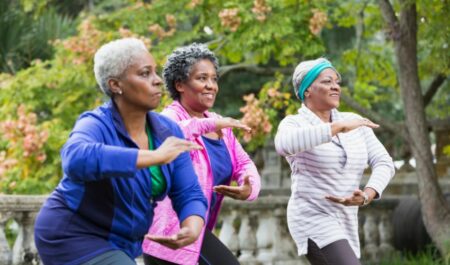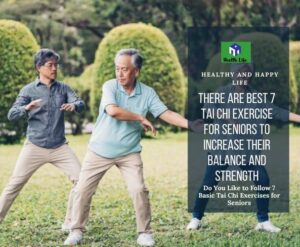When one thinks about martial arts, images of kicking and hitting come to mind, as well as intense training and physical contact. There is a traditional form of martial arts that does not encourage violence or the use of self-defense, despite the fact that many forms of martial arts entail strenuous combat tactics. For seniors and other folks in their latter years who are seeking for a low-impact exercise that yet improves their health, Tai Chi is an excellent option.And here are going to examine about what are the best suitable tai chi exercises for seniors and how to do them as effectively to active their age.

What Exactly is Tai Chi?
Tai chi has been practiced for the countless centuries that it has been around for a cause. Tai chi is an ancient Chinese martial art that combines movement with meditation and has been given the nickname “the exercise for a long life.” It consists of a sequence of motions that are carried out in a deliberate, rhythmic, and concentrated way, and it is accompanied by deep breathing. To guarantee that the body is moving continuously, one movement seamlessly transitions into the next without stopping in between.
These exercises are ideal for older citizens because they do not include competition, they have a minimal impact, they may be done at the participant’s own speed, and they combine light physical activity with stretching of the muscles to help avoid injury. The soft, flowing movements of tai chi are excellent for promoting relaxation, relieving tension, and cultivating a present-focused consciousness.
What are the Advantages of Practicing Tai Chi?
The Chinese people who engage in Tai Chi believe that this form of exercise may slow down the aging process, add years to one’s life, make one more flexible, and improve the strength of one’s muscles and tendons. Many Tai Chi practitioners also feel that the practice may be beneficial in the treatment of a wide variety of conditions, including but not limited to heart disease, high blood pressure, arthritis, skin problems, and others.
A meta-analysis, which is a research that combines the findings of several other studies, was done on Tai Chi, and the findings indicated that Tai Chi did, in fact, have a beneficial influence on one’s health, fitness, and balance.
The following is a list of the supported advantages of Tai Chi for your health:
- Improves Balance.
- Strength and Endurance are both increased as a result.
- Stress, anxiety, and depression are all alleviated to a certain degree.
- Reduces the Anxiety Associated with Falling
- Boosts One’s Own Self-Confidence
- Improves Aerobic Capacity.
- Improves the Overall Quality of One’s Sleep
- Improves Overall Well-being.
Here are seven fundamental Tai Chi exercises to get your practice started:

1. Warming Up.
To assist in the prevention of injuries and to make Tai Chi motions easier, it is essential to do a warm-up before beginning any Tai Chi session. Within the pages of her book titled “Stay Young with Tai Chi.” According to Ellae Elinwood, a Tai Chi instructor, warm-ups in Tai Chi “create a calm attitude and encourage a feeling of well being.”
The exercise known as “waist loosening” is a good illustration of a fundamental Tai Chi warm-up:
- Maintain a standing position with your feet planted firmly on the ground and your legs slightly spread apart from one another.
- Put your arms at your sides and relax.
- While allowing your arms to hang at your sides in a relaxed manner, rotate your hips to the right and left. Your arms should be flapping against your torso during each turn as you do the move.
- Repeat for one to two minutes, or until you feel as though your body has reached the desired temperature.
- You will then be able to rotate your neck, shoulders, and spine, which will ensure that each action is performed smoothly.
2. Reach Up and Touch the Sky.
This is an easy workout that is great for those who are just starting out with Tai chi. Domingo Colon outlines it in his book “Senior’s Tai Chi Workout: Improve Balance, Strength, and Flexibility.” Because it helps to coordinate breathing and movement, this exercise is also an excellent way to warm up before engaging in a more strenuous workout.
- Place yourself in a supportive chair and sit up straight.
- Place your hands on your lap with the palms facing up and your fingertips pointing toward one another. Do this while sitting in a chair.
- While you take a slow and deep breath in, bring both hands to the level of your chest in front of you, turn your palms so that they face outward, and then raise both hands above your head.
- Be careful not to reach too far with your arms, and maintain a relaxed but slightly bent elbow position.
- As you let your breath out in a long and deliberate manner, further relax your arms and slowly lower them to your sides.
- At the end of the breath, bring your hands back to the beginning position with your palms facing upward. This completes one breath.
- Repeat this process ten times.
3. Windmill Exercise.
This simple movement can help you become more flexible while also opening up your spine.
- Maintain a standing position with your feet planted firmly on the ground and your legs slightly spread apart from one another.
- Put an end to the strain, and loosen up your shoulders. You should let your arms dangle at your sides in a relaxed manner.
- Place both hands in front of your body with the fingers of both hands pointing down toward the ground.
- Take a deep breath in, pull your arms up towards the center of your body, and then lower them back down behind your head while pointing your fingers.
- You should also arch your back slightly while you perform this stretch. Stretch toward the ceiling.
- Exhale, then move your hands down through the center of your body as you bend forward at the waist until your back is parallel to the floor.
- Make a forward bending motion from the hip, and allow your arms to hang in front of you in a relaxed manner.
- Take a deep breath in, and then come back to the beginning posture.
4. Exercises for the Hands.
Shoulders, arms, and fingers all benefit from increased flexibility as you practice the Tai Chi hand exercises.
- You should stand with your feet somewhat more apart than the distance between your shoulders.
- Raise both arms in front of you until they are perpendicular to the ground. Ensure that your shoulders, wrists, and elbows are in alignment.
- Feel the stretch in your hands as you flex them, and then rotate your wrists to the left, alternating with a rotation to the right.
5. Striking a Closing Posture.
The Closing Posture, which is often done at the end of a Tai Chi practice, is designed to bring your energy back into balance while also promoting relaxation and calmness.
- Maintain a shoulder-width distance between your feet when you stand. Put your shoulders at ease and bring your hands together in front of your pelvic bone in a cupped posture with your palms facing upward.
- As you move your hands up to the center of your body and onto your chest, close your eyes and think that you are drawing your energy higher. At the same time, imagine that you are pushing your energy upwards.
- You should exhale and then turn your hands so that the palms are facing down. Imagine that as you bring your hands closer to the ground, you are also bringing your energy with you.
- Perform this exercise for a total of one to two minutes.
6. Shooting The Bow.
This is a rather straightforward standing workout.

- You should be standing with your feet about the width of your shoulders apart, and your arms should be swinging loosely at your sides.
- Relax your shoulders, round your back, and bend your knees ever-so-slightly while maintaining a forward-facing gaze.
- Form your hands into fists and position them in front of your face, making sure that your fingers are pointing in the direction of your face and that the heels of your palms are contacting the sides of your face.
- Take a calm and deliberate few breaths in.
- While you slowly and deeply inhale, twist your body to the left at the waist so that you are facing the left side of the room. At the same time, extend your left hand in front of you.
- When you open your left hand, the palm of your hand should face outward. Your left arm should be loose and bent at the elbow just a little bit.
- At the same time, move your right fist slightly backwards, as if you were launching an arrow from a bow.
- As you come back to the beginning posture, let out an exhalation that is slow and deep.
- Repeat the phrase “on the side” when you draw your next breath.
- Perform up to ten repetitions in total.
7. The Golden Lion Shakes its Mane.
- Find a seat that’s just right for you, sit up straight, and put your hands on your thighs in a relaxed yet supportive position.
- Make yourself at home and remember to take deep breaths. While releasing your breath, take a few gradual steps forward and feel the stretch in your lower back.
- Twist your shoulders to the side as you feel the stretch coming on, allowing your head and neck to turn in conjunction with your shoulders and spine.
- While you are twisting your back so that it faces forward and returning to the beginning position, inhale softly.
- Perform the action again while facing the opposite side.
- As you inhale, reverse the action that you just did so that you are back in the starting position.
- Perform as many repetitions on each side up to a maximum of 10.
Tai chi may be practiced successfully even by elderly people with mobility restrictions. They will be able to maintain their fitness level with the aid of these workouts without the risk of injury associated with strenuous activity. Seniors can benefit from relaxation, rejuvenation, and keeping their blood circulating by including Tai Chi as one of their weekly hobbies.
Tai chi is a workout that is gradual and gentle, making it appropriate for elderly persons who suffer from chronic sickness. The benefits of flexibility, muscular building, and endurance training are all offered by this particular exercise. Elderly people who practice Tai Chi may see an improvement in their health without a worsening of any pre-existing conditions.
How frequently should I engage in the practice of tai chi? We suggest that you practice for at least ten minutes each day, even if it’s just a little amount. Tai chi has been shown to have positive effects on health when practiced on a regular basis.
Regular tai chi practice has been shown to lead to a reduction in body fat. A group of people who practiced tai chi for 45 minutes, five times per week were followed over the course of one research to see how their weight changed. Without making any other adjustments to their lifestyle, these people were able to lose a little more than a pound at the conclusion of the 12 week period.
